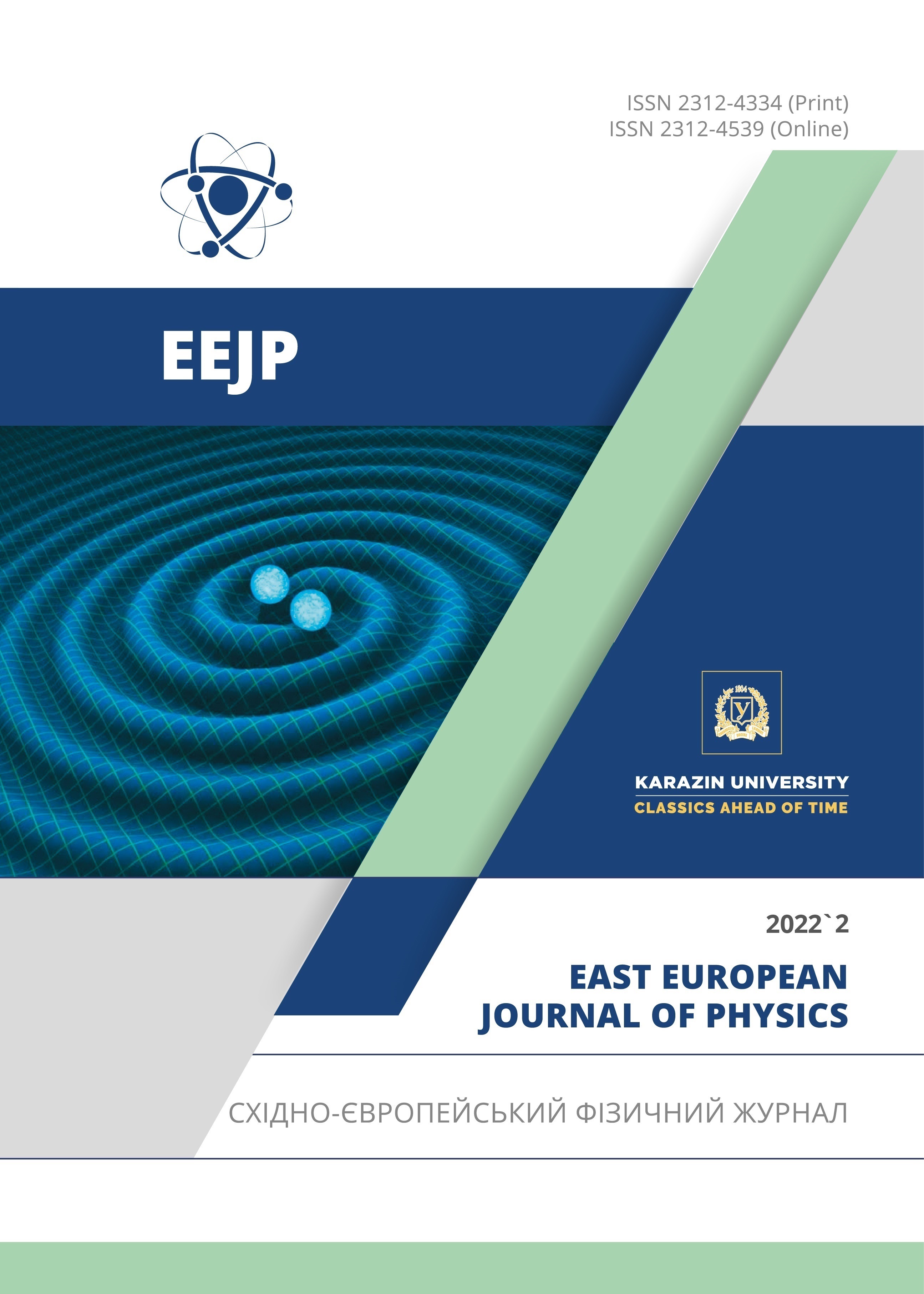Взаємодія нового фосфонієвого зонду з ліпідними мембранами: флуоресцентне дослідження
Анотація
За допомогою методів флуоресцентної спектроскопії та молекулярного докінгу досліджено молекулярні механізми взаємодії між новими монометиновими ціаніновими зондами та нефібрилярними та фібрилярними білками. З цією метою, було досліджено флуоресцентні спектральні властивості зондів в буфері та в присутності інсуліну та лізоциму в нативних та амілоїдних станах. Встановлено, що асоціація монометинів з нефібрилярними та фібрилярними білками супроводжувалася значним зростанням інтенсивності флуоресценції барвників, що було більш вираженим в присутності агрегованого інсуліну та лізоциму. Шляхом апроксимації експериментальних залежностей збільшення інтенсивності флуоресценції флуорофору від концентрації білка моделлю Ленгмюра було отримано кількісну інформацію щодо зв'язування зондів з білками. Аналіз спектральних властивостей і отриманих параметрів зв'язування монометинів у присутності фібрилярного інсуліну та лізоциму показав, що хлор- і фтор-замісники в структурі похідних оксазолового жовтого, а також довгі аліфатичні групи на атомі азоту бензазолового фрагменту YO-барвників негативно впливають на амілоїдну специфічність барвників. З використанням молекулярного докінгу показано, що монометини мають тенденцію утворювати найбільш стабільні комплекси із залишками Val 17, Leu17, Ala 14, Phe1, Gln 4 і Leu 6 B-ланцюга і залишками Leu 13, Tyr 14, Glu 17 A-ланцюга нефібрилярного інсуліну та з гідрофобними Ile98, Ile 58, Thr108, Thr 62 and Thr 63 i негативно зарядженими Asp101, Asp 107 амінокислотними залишками нативного лізоциму. Отримано, що жолобки фібрил, що утворені амінокислотними залишками Gln15_Glu17 в фібрилярному інсуліні та G2-L4/S8-W10 в фібрилах лізоциму є найбільш енергетично вигідними сайтами зв’язування для монометинових зондів.
Завантаження
Посилання
T. Ishiguro, J. Saitoh, H. Yawata, M. Otsuka, T. Inoue, and Y. Sugiura, Nucleic Acids Res. 24, 4492-4497 (1996), https://doi.org/10.1093/nar/24.24.4992
A.S. Biebricher, I. Heller, R.F.H. Roijmans, and T.P. Hoekstra, et al, Nat. Commun. 6, 7304 (2015), https://doi.org/10.1038/ncomms8304
M. Wong, S. Kong, W. H. Dragovska, and M.B. Bally, Biochim. Biophys Acta, 1527, 61-72 (2001), https://doi.org/10.1016/S0304-4165(01)00149-50
A. Rozman, I. Crnolatac, T. Deligeorgiev, I. Piantanida, and J. Luminesc. 205, 87-96 (2019), https://doi.org/10.1016/j.jlumin.2018.08.074
A. Furstenberg, T. Deligeorgiev, N. Gadjev, A. Vasilev, and E. Vauthey, Chem. Eur. J. 13, 8600-8609 (2007), https://doi.org/10.1002/chem.200700665
H. Rye, S. Yue, D. Wemmer, M. Quesada, P. Haugland, R. Mathies, et al. Nucleic Acid Res. 20, 2803-2812 (1992), http://dx.doi.org/10.1093/nar/20.11.2803
C.U. Murade, V. Sabramaniam, C. Otto, and M.L. Bennink, Biophys. J. 97, 835-843 (2009), https://doi.org/10.1016/j.bpj.2009.05.024
S. Gurrieri, K. Wells, I. Johnson, and C. Bustamante, Anal. Biochem. 249, 44-53 (1997), http://dx.doi.org/10.1006/abio.1997.2102
Y. Sato, S. Yajima, A. Taguchi, K. Baba, M. Nakagomi, Y. Aiba, and S. Nishizawa, ChemComm. 55, 3183-3186 (2019),
O. Cavuslar, and H. Unal, RSC Advances. 5, 22380-22389 (2015),. http://dx.doi.org/10.1039/C5RA00236B
M. Eriksson, M. Härdelin, A. Larsson, J. Bergenholtz, B. Akerman, J. Phys. Chem. B 111, 1139-1148 (2007), http://dx.doi.org/10.1021/jp064322m
K. Vus, U. Tarabatra, Z. Balklava, D. Neruch, M. Stich, et al, J. Mol. Liq. 302, 112569 (2020), http://dx.doi.org/10.1016/j.molliq.2020.112569
M. Thompson, Bioconjugate Chem. 17, 507-513 (2006), http://dx.doi.org/10.1021/bc050307t
D.J. Lindberg, and E.K. Esbjorner, Biochem. Biophys. Res. Commun. 469, 313-318 (2016), http://dx.doi.org/10.1016/j.bbrc.2015.11.051
S. Stefansson, D.L Adams, and C.-M. Tang, Biotechniques, 52, 26307253 (2012), http://dx.doi.org/10.2144/000113873
K. Vus, V. Trusova, G. Gorbenko, E. Kirilova, G. Kirilov, I. Kalnina, and P. Kinnunen. Chem. Phys. Lett. 532, 110-115 (2012), http://dx.doi.org/10.1016/j.cplett.2012.02.061
S. Dallakyan, and A.J. Olson, Methods Mol. Biol. 1263, 243-250 (2015), https://doi.org/10.1007/978-1-4939-2269-7_19
P. Csizmadia, In: Proceedings of ECSOC-3, the third international electronic conference on synthetic organic chemistry, 367-369 (1999), https://doi.org/10.3390/ECSOC-3-01775
M.D. Hanwell, D.E. Curtis, D.C. Lonie, T. Vandermeersch, E. Zurek, and G.R. Hutchison, J. Cheminform. 4, 17 (2012), https://doi.org/10.1186/1758-2946-4-17.
V. Trusova, East Eur. J. Phys. 2, 51-58 (2015), https://doi.org/10.26565/2312-4334-2015-2-06
E.F. Pettersen, T.D. Goddard, C.C. Huang, G.S. Couch, D.M. Greenblatt, E.C. Meng, and T.E. Ferrin. J. Comput. Chem. 25, 1605-1612 (2004), https://doi.org/10.1002/jcc.20084
C.C. Kitts, T. Beke-Somfai, and B. Norden, Biochemistry, 50, 3451-3461 (2011), https://doi.org/10.1021/bi102016p
R. Mishra, D. Sjölander, and P. Hammarström, Mol. Biosyst. 7, 1232-1240 (2011), https://doi.org/10.1039/C0MB00236D
O. Zhytniakivska, A. Kurutos, U. Tarabara, K. Vus, V. Trusova, G. Gorbenko, N. Gadjev. And T. Deligeorgiev, J. Mol. Liq. 311, 113287 (2020), https://doi.org/10.1016/j.molliq.2020.113287
P.L. Donabedian, M. Evanoff, F.A. Monge, D.G. Whitten, and E.Y. Chi, ACS Omega, 2, 3192-3200 (2017), https://doi.org/10.1021/acsomega.7b00231
K. Volkova, V.B. Kovalska, M. Losytskyy, K.O. Fal, N.O. Derevyanko, et al. J. Fluoresc. 21, 775-784 (2011), https://doi.org/10.1007/s10895-010-0770-6
O. Ryzhova, K. Vus, V. Trusova, E. Kirilova, G. Kirilov, G. Gorbenko, and P. Kinnunen, Methods Appl. Fluoresc. 4, 034007 (2016), https:// /doi.org/10.1088/2050-6120/4/3/034007
V. Kovalska, S. Chernii, M. Losytskyy, I. Tretyakova, Y. Dovbii, A. Gorski, et al. New. J. Chem. 42, 13308-13318 (2018), https://doi.org/10.1039/C8NJ01020J
S. Salentin, S. Schreiber, V.Joachim Haupt, M.F. Adasme, and M. Schroeder, Nucleic Acids Res. 43, W443-W447 (2015), https://doi.org/10.1093/nar/gkv315
W. Peng, F. Dei, Y.-K. Peng, U.-T. Jiang, and L. Zang. J. Agr. Food Chem. 61, 12415-12428 (2013), https://doi.org/10.1021/jf4039327
M. Biancalana, and S. Koide, Biochim. Biophys. Acta, 1804, 1405–1412 (2010), https://doi.org/10.1016/j.bbapap.2010.04.001
Авторське право (c) 2022 О. Житняківська, У. Тарабара, А. Курутос, К. Вус, В. Трусова, Г. Горбенко

Цю роботу ліцензовано за Міжнародня ліцензія Creative Commons Attribution 4.0.
Автори, які публікуються у цьому журналі, погоджуються з наступними умовами:
- Автори залишають за собою право на авторство своєї роботи та передають журналу право першої публікації цієї роботи на умовах ліцензії Creative Commons Attribution License, котра дозволяє іншим особам вільно розповсюджувати опубліковану роботу з обов'язковим посиланням на авторів оригінальної роботи та першу публікацію роботи у цьому журналі.
- Автори мають право укладати самостійні додаткові угоди щодо неексклюзивного розповсюдження роботи у тому вигляді, в якому вона була опублікована цим журналом (наприклад, розміщувати роботу в електронному сховищі установи або публікувати у складі монографії), за умови збереження посилання на першу публікацію роботи у цьому журналі.
- Політика журналу дозволяє і заохочує розміщення авторами в мережі Інтернет (наприклад, у сховищах установ або на особистих веб-сайтах) рукопису роботи, як до подання цього рукопису до редакції, так і під час його редакційного опрацювання, оскільки це сприяє виникненню продуктивної наукової дискусії та позитивно позначається на оперативності та динаміці цитування опублікованої роботи (див. The Effect of Open Access).








